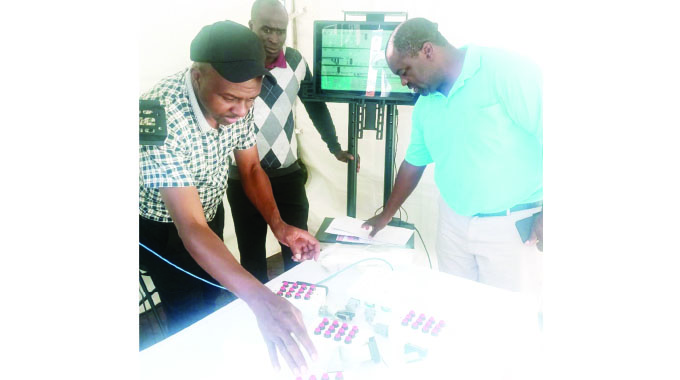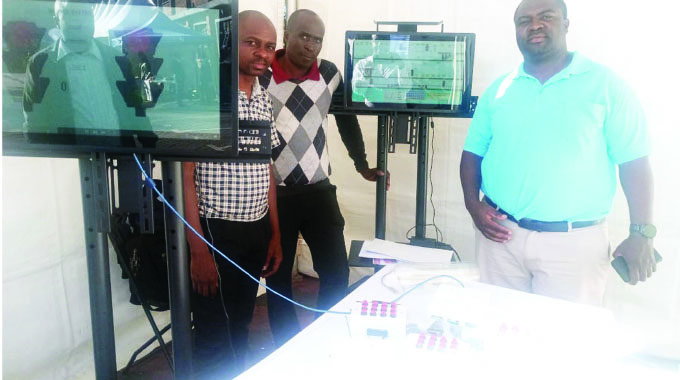Source: The Herald – Breaking news.

Sifelani Tsiko
Innovations Editor
University of Zimbabwe Computer Science PhD students have used the institution’s Innovation Hub to develope a wireless railway digital signalling technology system that has the potential to enhance safety and speed up train movement in the country’s rail network plagued by vandalism and destruction of vital communication systems.
Research team leader Kumbirai Mukosera (42) told The Herald at the UZ Research Innovation and Industrialisation Week which opened this week, that they had designed a prototype wireless railway signalling system that could save the country millions of dollars and enhance the efficiency of the National Railways of Zimbabwe.
“We have developed a wireless non-potrusive system for railway signalling that can address the problem of vandalism and theft of railway equipment that has affected the communication system of the NRZ,” he said.
“The wireless system links wayside equipment, signalling control rooms and the locomotives themselves. There is no need for copper cables which are the main target of thieves.
“To rehabilitate or repair the stolen cables and equipment or to install a modern digital communication system for the NRZ can cost the NRZ up to US$1 billion. With our new smart railway communication system, revamping the whole system will not cost more than US$100 million.”
Kumbirai, Michael Sanyahukwe (41) and Tinashe Gwevo (42) have teamed up to develop a smart railway communication system that can link signalling, rolling stock and traffic control systems on a common platform.
The researchers said the entire network will be able to communicate seamlessly and instantaneously, helping to overcome the problem brought about by the vandalisation of NRZ infrastructure.
“We have come up with a smart railway communication system for our rail operator that embraces new trends in artificial intelligence and IT to help change the aging telecommunications architecture of more than 20 years ago,” said Kumbirai.
“This new wireless system is modern and is able to meet current and future requirements.”
The sheer size and scale of Zimbabwe’s rilway network – more than 3 000 km of track across all regions of the country has made it impossible to cost-effectively monitor all corners of the network.
This means that mission – critical sites are protected permanently and others are left exposed to criminal activity.
The electrified (25kV AC) 313km Gweru-Harare section was vandalized heavily and electric trains have since stopped operating.
Transport analysts say the neglect of maintenance, lack of spare parts and overdue replacement of equipment had led to inefficiency and reduced rail services.
In 2022, NRZ reported that it had lost over US$3,6 million between 2018 and 2019 to theft and vandalism of its rail infrastructure.
Vandalism of key infrastructural installations and other ancillary equipment also includes theft of copper cables, wagon and transformer components, steel sleepers and quarry stones (ballasts) used to stabilise railway tracks.
“Digitisation of communication systems for the NRZ can help reduce these problems and modernise the network to deliver more frequent, reliable and safe services without disrupting the movement of cargo and passengers,” Kumbirai said.
“It’s at prototype level and we have done field trials already. The trials were successful and we intend to work closely with the UZ Innovation Hub, NRZ and the government to push for the commercialisation of our research outputs.
“We can still use the remaining existing good infrastructure and equipment to resuscitate the whole NRZ signalling system.”
Railway operations are becoming increasingly automated and integrated through the usage of Information and Communication Technology (ICT).
Through wireless signalling systems, Kumbirai said it was possible to enable the railway operator to increase the number of trains on the same track safely without large infrastructure investments.
The UZ Computer Science PhD students started the research 11 years ago and have refined their outputs through technology upgrades.
The students have set up a start-up company – Chipleton Telecommunication Systems to drive their prototype to the commercialisation stage.
“We are now working at the UZ Innovation Hub because of the sheer size and scale of the project. We have done trials and I am confident that this will save the country millions of dollars in foreign currency,” Kumbirai said.
“We have designed circuits and systems using locally available materials. We buy passive imported components which are found locally. With political will and funding, this new signalling system can be rolled out to enhance the efficiency of the NRZ.”
NRZ has an important transit function in southern Africa, linking countries in the south to the interior of Africa.
The University of Zimbabwe now has a vibrant Innovation Hub which is at the forefront of cutting edge discovery and knowledge production ever since the country started the implementation of heritage – based Education 5.0 for the modernisation and industrialisation of the country.
Education 5.0 is based on five major components that include teaching, research, community service, innovation and industrialisation.
University of Zimbabwe Research Innovation and Industrialisation Week aims to showcase new frontiers of knowledge and emerging technology that seeks solutions to some of the national and community problems
“This has been inspired by the government of Zimbabwe’s Heritage-based Education 5.0 Philosophy. The philosophy pushes for the development of new competencies for generation of innovations and new industries and entrepreneurs,” said UZ Vice Chancellor Prof Paul Mapfumo.
“We are creating the evidence of benefits of Science, Technology and Innovation and this will motivate young people in primary and secondary schools to participate in building and maintaining a vibrant economy; complementing the Government’s mantra, “Nyika inovakwa nevene vayo.”
COMMENTS